Every sailor has his own vision of the perfect daysailer. For many, this ideal boat is based on the Herreshoff 12 1⁄2, Nathanael G. Herreshoff’s iconic daysailer, which debuted in the summer of 1915. For others, it’s the larger Fish class or the still-larger Alerion—two more masterworks from the hand of Herreshoff. These boats have been the subject of imitation and interpretation ever since they hit the water over 100 years ago. The Flatfish, designed in the early 1990s, is Joel White’s version of Herreshoff’s Fish.
In 1992, I was looking for a boat to build for my parents, then in their late 60s. They weren’t going cruising anymore, so I was looking for their perfect daysailer. The boat had to be big enough so that they wouldn’t get physically knocked around, and it had to be trailerable. My folks wanted something they could sail on the Hudson and take to both Maine and the Chesapeake. As with any daysailer, the destination becomes less important while the experience of sailing grows. In other words, she had to look good and perform well.
Picking a boat is always a balance of beauty, performance, cost, and, in this case, opportunity. A conversation with Maynard Bray, WoodenBoat magazine’s technical editor, led to an offer to build the first Flatfish, a design project he was working on with Joel White. It was an offer I couldn’t refuse. The boat sounded perfect for my parents’ requirements, and I thought I could build it in a year of half-time work.
 Photo by Alison Langley
Photo by Alison LangleyFlatfish is Joel White’s adaptation of Nathanael G. Herreshoff’s century-old Fish-class sloop. The Fish class is a keelboat; the principal modification in the Flatfish is the addition of a centerboard—and the subtraction of some draft. The boat pictured above and on the opposite page was built by Chip Flanagan of Portland, Maine, who’s at the helm.
When I first spoke with him, Joel had just done the initial drawings. Joel’s objective was to make the Fish trailerable, while retaining all the wonderful qualities of the original. Designed toward the end of Joel’s career, the Flatfish incorporates his experience as a leading builder and designer, and “does no harm” to Herreshoff’s design. The result is a boat with elegant looks. Every curve is right. A few inches over 20′ long, she’s big enough to sail comfortably with six people, but small enough to be easily singlehanded. With a gaff main and a club jib, her simple sloop rig tacks with one move of the tiller and the change of a running backstay. The hull is heavy enough to stand up to a stiff breeze or to carry its way through flat spots and shoot directly into the wind up to a mooring. It’s also slippery enough to accelerate quickly and outpace most boats under 30′, and with the cockpit close to the water there’s a real feeling of speed.
The Flatfish is Joel White’s second direct interpretation of N.G. Herreshoff’s classic hull shape. The first, the Haven 12 1⁄2, has been built by hundreds of professional and amateur builders—my shop included. Shallower and broader than Herreshoff’s originals, both of White’s designs use a keel-centerboard arrangement to maintain performance while making the boats trailerable. There are differences between the Haven and the Flatfish, especially in accommodations, building time, and hull speed. The larger boat comfortably accommodates two more people, and the cuddy cabin allows for stowage and the possibility of a porta-potti. In use, the dockage and launching fees for the Flatfish will be higher. She’s trailerable, but not easily launched at a ramp. She really needs a lift to launch and some mechanical advantage to step the mast. Once rigged, both boats require the same work to get underway.
The building process of the two boats is almost identical and is well documented in Maynard Bray’s book Building the Haven 12 1⁄2. That said, the Flatfish is a lot more boat to build than the Haven. There’s more of everything— building molds, planks, frames, deckbeams. There’s also the cuddy cabin. Comparing the displacement of the hulls minus the ballast, one of White’s own cost-estimating techniques, provides a good indicator of the relative work involved in building the two boats. The Flatfish weighs 1,300 lbs compared to the Haven’s 800 lbs—a factor of 1.625. I found this ratio to be even a little low when applying it to building hours. The time required to build a Flatfish is closer to double that for a Haven, probably because the shorter boat can utilize more one-piece planks and smaller stock. Both the Haven and the Flatfish are designed to be built using the Herreshoff method, which involves one mold for each steamed frame. It’s a lot of work for a single boat, but it makes for a very fair hull and certainly works well for a production boat. It also makes a boat that lasts. There are many hundred-year-old Herreshoffs still sailing. This boat requires 22 molds for the Herreshoff method, while it probably take less than half that number for a conventionally planked carvel hull.
On the water the Haven is evenly matched with its sibling Herreshoff 12 1⁄2. Joel wasn’t able to achieve the same parity with the larger boats. The Flatfish is slightly faster than the Fish. We proved this by match-racing my folks’ Flatfish with an original Fish. Both had new sails and the better helmsman was in the Fish, yet the Flatfish just slightly outpaced the original. (I think the centerboard is the culprit, providing better windward ability.) The profiles of the boats are very similar; there’s a slight difference in the run aft. The real difference is the Flatfish’s broader beam. It’s especially noticeable when the two boats are side by side, on shore or in the water.
Another design goal was to make the boat trailerable for easy transport and storage. My parents’ boat has logged several thousand miles on its trailer. The hull seems no worse for the wear. She also has spent every winter stored in the backyard under a temporary garage. Having her at home allows for convenient maintenance and really makes the boat a part of the family.
 Photo by Alison Langley
Photo by Alison LangleyAn original Herreshoff Fish, SHARK, near Noank, Connnecticut. The Fish is narrower and deeper than the Flatfish; the greater beam of the Flatfish compensates for the reduced stability caused by the newer design’s shallower keel.
The boat sails wonderfully well with its gaff rig. She points well, has real power on anything close to a reach, and has low heeling moment. White also drew a marconi rig, but I have no experience with it.
Almost ten years of sailing has exposed only one design flaw: We haven’t found a good way to add an outboard or other auxiliary power, aside from an oar. The transom rake is the main culprit. Electric motors can accommodate the rake, but they lack enough power to punch the boat into a real breeze. Side-mount brackets allow for a gas motor, but the motor swamps when the boat rolls. The stern-mount bracket used on the fiberglass 12 1⁄2 s built by Cape Cod Shipbuilding also tends to dunk the motor in any sort of sea. With all solutions, the motor needs to be removed for sailing and stored in the boat; otherwise, it fouls the mainsheets. Cutting an outboard well into the bottom planking has also been tried, but it’s very intrusive and it slows the boat. The best solution is just to sail off a mooring, plan well, and pay attention to wind and tide.
With the Flatfish design, Joel White followed the engineer’s maxim of not putting one extra piece of wood in the boat, and the designer’s rule of not placing one extra line on the drawing. The design does everything it’s supposed to do: It provides a sweet-lined, capable, transportable boat.
I’d certainly like to live in a house on a rock-lined coast with my boat on a mooring that I can see from my back window. I don’t. This boat’s combination of trailerability, good sailing qualities, and classic elegance (along with rental cottages) makes that world accessible. It’s a wonderful boat to sail off a mooring on the morning’s outgoing tide, take a picnic lunch, and catch the incoming tide as the breeze dies at the end of the day.

Aficionados of the Herrehsoff 12 1⁄2 and the Haven 12 1⁄2 will recognize these boats in the Flatfish’s lines and sailplan (just as the Flatfish is a modification of the original Herreshoff Fish, the smaller Haven is a modification of the 12 1⁄2 ). The Flatfish is trailerable, but most sailors will want to use a Travelift to move the boat onto a trailer.
This article appears here as archival material. Boat plans ere available from The WoodenBoat Store, but are currently out of stock as of August 2024.
Is there a boat you’d like to know more about? Have you built one that you think other Small Boats Magazine readers would enjoy? Please email us!

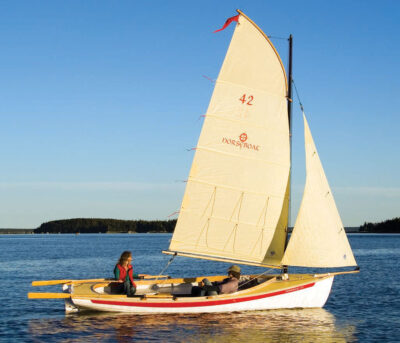



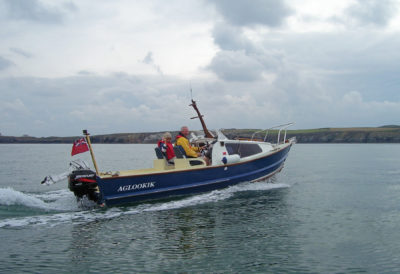



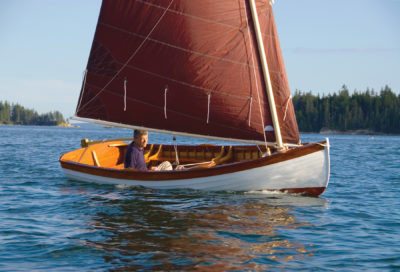

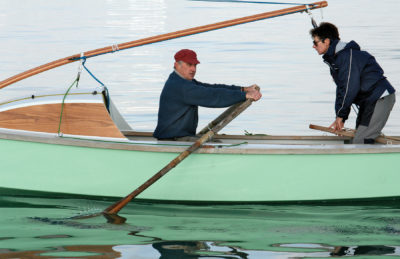



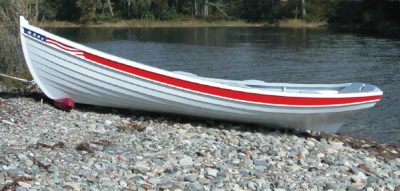


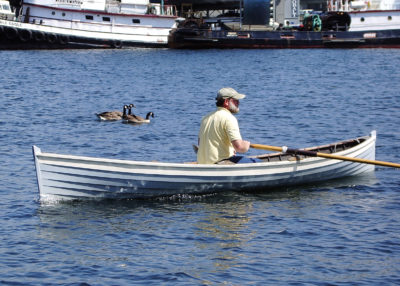








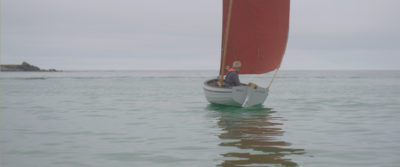
I don’t understand why this wonderful boat should not be fitted with an electric motor. There are at least three equally good solutions. A shaft drive with a shaft shifted to one side. A pod drive also situated asymmetrically. The third would be to integrate a pod drive into the rudder. This has been done for a Folkeboat. All three solutions would come with a folding prop.
I haven’t sailed a Flatfish, but having taught adult sailing classes in a Fish class out out the Herreshoff Marine Museum in Bristol, RI, if the Flatfish sails half as well as the Fish it will be a phenomenal sailing craft. The Fish class is surprisingly nimble, while at the same time being stable and easy to sail. A stellar sailing boat.
I will add the Flatfish to boats I may someday think about building.